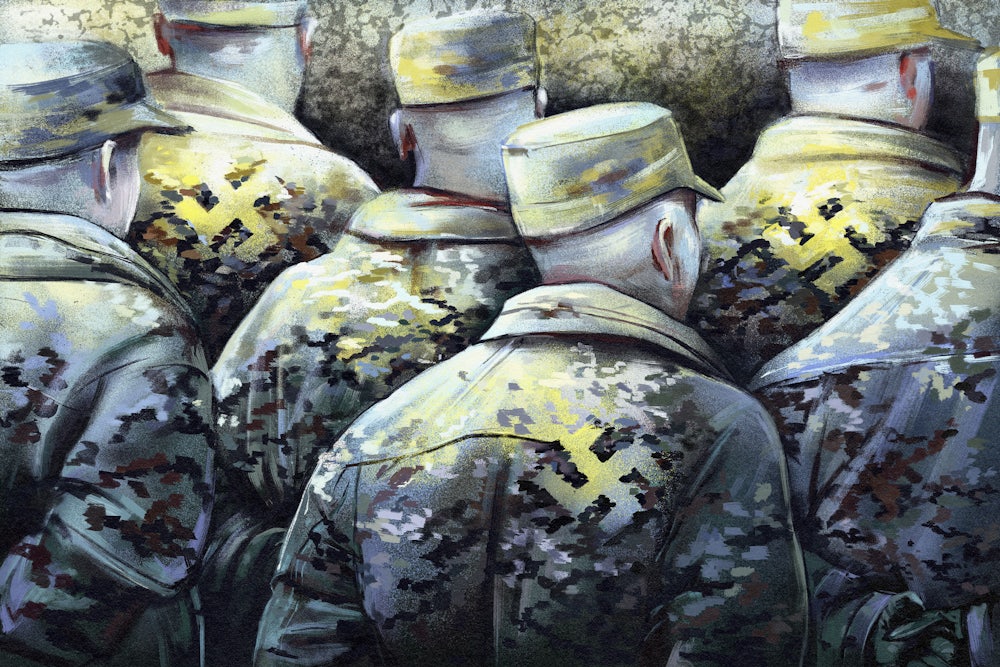In late October 2020, Lance Corporal Joseph Mercurio, a Marine with the 2nd Battalion of the 4th Marine Regiment, hit “send” on an Instagram comment: “The Jewish religion is that of Satan,” he wrote—responding to a photograph of me. His username on Instagram, “joe88mercurio,” incorporated a known neo-Nazi code: 88 stands for “Heil Hitler,” as H is the eighth letter of the alphabet.
In his bio, Mercurio stated his affiliation with the Marines: “USMC 0331,” a numerical designation indicating that he was responsible for handling machine-guns in direct combat. Below, he included a quote from an interview with neo-Nazi Richard Spencer—“There is no equality in nature, there’s difference”—and a quote from the white supremacist band Skrewdriver, from a song lauding Nazi troops in World War II as the “forces of light” in a “holy war.”
I had published a book on the white supremacist movement in the United States days earlier, and Mercurio had sought me out on Instagram to make his ire felt. Irked by the idea of a deployed machine-gunner being so open about his extremist sentiments, I screenshot the comment he left on my post, as well as a post by Mercurio showing him tagged alongside military colleagues at the training base Camp Pendleton in Southern California, and posted it to Twitter.
Within a day, a Marine spokesperson told military-news outlet Task & Purpose that Mercurio was under investigation. The publication had uncovered further racist and antisemitic material on Mercurio’s Facebook page: a cartoon from neo-Nazi site The Daily Stormer, accusations that Trump had betrayed the U.S. for Israel’s sake, and comparison of anti–police brutality protesters to “wild animals.” According to Marine spokesman Captain Joe Butterfield, the investigation would be thorough. “We are serious about holding ourselves accountable,” he said.
When I followed up six months later to find out what consequences, if any, had befallen Mercurio, a different Marine spokesperson, Captain Andrew Wood, gave an emphatic response. “There is no place in the Marine Corps for supremacist or extremist activity,” he said. Mercurio had been demoted from lance corporal to private, with unspecified disciplinary action and further administrative action “pending.” When I followed up again to ask if Mercurio was still deployed, and still using military weapons on a daily basis, the response was dismaying: “He remains assigned to that battalion and continues to train in his assigned role as a machine-gunner, but has not been sent for advanced training since being investigated.”
Marine investigators had determined that Mercurio’s open extremist sentiments were serious enough to merit punitive action. But far from there being “no place in the Marine Corps” for such individuals, his place was where it had been all along: in the ranks of a battalion, training with fully automatic guns capable of firing up to a thousand rounds a minute. The young Pennsylvanian who celebrated Hitler and gleefully indulged in his beliefs that some races are biologically inferior to others was still being trained with some of the most fearsome weaponry in the world.
“The Jewish religion is that of Satan,” he’d written. I kept thinking about a thousand rounds a minute and what they could do. And Mercurio, I knew, was far from alone.
The issue of extremism in the military has drawn national attention in recent months, thanks to the disconcerting prevalence of current and former servicemen during the January 6 storming of the Capitol building. An estimated 13 percent of arrests in ongoing law enforcement operations against the insurrectionists have snagged veterans or currently serving soldiers, about double their share in the population at large.
Lloyd Austin, who took over as secretary of defense for the Biden administration, ordered a military-wide, one-day “stand down”—a formal pause in operations—in February to address the issue. He also announced a raft of anti-extremism proposals to cover the entirety of the roughly 1.3 million active-duty servicemen who fall under the bloated aegis of the Pentagon—from the National Guard to the Marines. Over the past decades, despite robust evidence that white supremacists and other extremists have penetrated the ranks of the armed forces, the military has declined to address the issue in a systemic manner.
During his confirmation hearing, Austin, the country’s first Black secretary of defense, alluded to a brutal incident that occurred during his service as a lieutenant colonel at Fort Bragg in 1995. In December of that year, a white paratrooper, James Burmeister II, accosted and shot a Black couple at point-blank range as they walked down a street in Fayetteville, North Carolina. Burmeister had been accompanied by two other paratroopers during the attack, which he hoped would earn him a coveted spiderweb tattoo: a neo-Nazi gang symbol meaning the bearer had killed a Black person.
Burmeister was ultimately sentenced to life in prison; an Army investigation found that he had openly displayed a swastika in his barracks and worn a Nazi medallion. He was not alone: Military investigators found that numerous members of Burmeister’s 82nd Airborne had demonstrable links to white supremacist groups.
While this incident might have shaped Austin’s declared determination to rid the ranks of racists and extremists, the secretary’s proposals to that end are remarkably modest thus far. The initiatives laid out in a February memo entail the commissioning of studies to ascertain the scope of the problem, tweaks to screening questionnaires, and the establishment of a working group on extremism.
Even if the Pentagon establishes much-belated information-gathering on the scale of white-supremacist permeation into the ranks and among veterans, there is no guarantee that such information would be available to the public, an unconscionable flaw. Such interventions, while welcome, hardly match the extent of a problem that threatens both to compromise the integrity of the military and endanger the society it purports to defend.
By its own admission, the Department of Defense doesn’t have a clue. An article published on Defense.gov in late March, citing Pentagon press secretary John F. Kirby, stated that “the Defense Department doesn’t have an idea about the scope of an extremism problem in the ranks.” In lieu of hard information, Austin’s stand-down merely focused on service members recommitting to the oath of service and reviewing impermissible behaviors.
Moreover, this emphasis on recommitment training was left to the discretion of commanders of various units, with soldiers complaining that some leaders offered perfunctory, abbreviated, or openly sardonic presentations of anti-extremism material. Official guidance on the stand-down from the secretary of defense reiterated the idea that “the vast majority of the men and women in the United States military and those who serve the Department of Defense as civilian employees … do not support racially and ethnically motivated violent extremists, including white supremacists.” This optimistic assertion contradicted the flatter and more accurate reality reflected in the Defense.gov article: “There are no numbers,” as C. Todd Lopez, a Pentagon official, put it.
The fact that such numbers are elusive to the public is unsurprising, given the Defense Department’s general lack of transparency. What is even more troubling, though, is the probability that concrete data on military extremism is unknown even to Department of Defense leadership. Considering the longevity and seriousness of the problem of white supremacists gaining access to military weaponry and training, this institutional lack of knowledge is in and of itself a staggering failure—one that points more to willful blindness than simple neglect. It’s also a lacuna that the military is incentivized to perpetuate.
As Spencer Ackerman, author of the forthcoming book Reign of Terror: How the 9/11 Era Destabilized America and Produced Trump, pointed out in an interview, over the past several decades the bulk of the military’s physical presence in the U.S. has shifted south and west, to predominantly conservative areas. “The military has never wanted to investigate this question,” he told me. “They have a structural disincentive—the military runs the risk of alienating a lot of its own people, depending on how hard it presses on this sore.”
Moreover, examining the ties between potential recruits or veterans and extremist groups that portray themselves as deeply, even fanatically patriotic presents a conflict that threatens the viability of the recruitment pipeline. Nationwide militia groups like the III% and the Oath Keepers have adopted military-style training, adhere to oaths of service, and define themselves principally as “patriots”—defenders of the country—in ways that align with military values, even as the groups’ far-right vigilante tendencies subvert the fragile harmony of a multiracial democracy.
“Functionally, the military seeks to recruit from some of the same cohort white supremacist groups target—young white people, men in particular, to whom the idea of a potentially violent life, or a life of sacrifice and struggle, is appealing,” Ackerman said. “The overlap in the Venn diagram is violent patriotism, and it’s a tremendous opportunity. It’s not an accident that the people who commit terrorism from a white-supremacist vantage point call themselves ‘patriots.’ Even when they’re trying to overthrow something, they’re trying to restore something essentially American as they define it.”
The porousness between far-right extremist movements and the military has persisted for decades. White supremacy in the military is not a new or even resurgent problem; it’s been a steady presence, a deliberate gambit on the part of the white power movement to obtain combat-trained recruits.
As Kathleen Belew put it in Bring the War Home, her seminal study of paramilitary white-power organization in the latter half of the twentieth century, the Aryan Nations developed a “sustained focus on recruiting veterans and active-duty military personnel” as far back as the late 1970s and early 1980s. Moreover, as Belew writes, military veterans have always had an outsize role in white-power violence, from Confederate veterans forming the first Klan, to the World War II veterans who comprised the vanguard of a Klan resurgence that struck back against the civil rights movement in the 1950s and ’60s.
Disciplinary records, transfers, and reasons for early discharge are not readily available to the public until 62 years after personnel leave the military. Under this official veil, extremist personnel—such as a cell of Marines who were open members of the Ku Klux Klan at Camp Pendleton in the 1970s and beat Black Marines with impunity—can be dispersed to different bases across the country, radicalizing those they encounter under the official imprimatur of “defusing the situation.” That a century-old issue should be answered with what amounts to little more than pablum—and that concrete statistics have not been sought or disseminated, as increasingly sophisticated armaments are placed in the hands of radicalized recruits—amounts to an utter abdication of responsibility.
Several of the most dramatic white supremacist incidents over the past few years have involved either veterans or enlisted military personnel. Among the cases that drew national media attention was that of Christopher Hasson, a middle-aged Coast Guard lieutenant sentenced to 13 years in prison in 2020, who stockpiled guns, knives, and tactical gear in his Maryland apartment; fixated on white-nationalist ideology, particularly the manifesto of Norwegian mass murderer Anders Breivik; and devised an elaborate plot to slaughter liberal politicians and cable news hosts.
Also in 2020, a 22-year-old paratrooper named Ethan Meltzer serving with the Army’s 173rd Airborne Brigade in Italy was intercepted before he could carry out a planned ambush on members of his unit, in what Department of Justice investigators described as a potential “mass casualty” event. Meltzer was affiliated with the Order of Nine Angles, a radical and violent sect centered on antisemitism, reverence of Adolf Hitler, and white supremacy.
While Meltzer and Hasson were thwarted before their plans could be carried out, an enlisted soldier who was part of a loosely organized far-right extremist movement known as the Boogaloo carried out a brief but bloody campaign of violence in California in the summer of 2020. (“Boogaloo” is a reference to a hoary Internet meme based on a 1984 breakdancing film, Breakin’ 2: Electric Boogaloo; for years, “Electric Boogaloo” was a humorous stand-in for any hypothetical sequel. Cherry-picking this motif from the vast memetic sprawl of the internet, far-right extremists named their movement in reference to the sequel they wished to create, through a campaign of stochastic and very real terror: a new American Civil War.) A self-described Boogaloo Boi and Air Force sergeant, 32-year-old Steven Carrillo, in collusion with an organized and armed Boogaloo-affiliated militia group known as the Grizzly Scouts, allegedly killed a federal protective security officer at Oakland’s federal courthouse and seriously wounded another.
A week later, the object of a wide-ranging manhunt, Carrillo ambushed deputy sheriffs and California Highway Patrol officers with a silenced semiautomatic rifle and homemade pipe bombs, allegedly killing one and wounding two. During the gun battle, he scrawled the word “BOOG” on the hood of a car in his own blood. Carrillo has been charged with murder and attempted murder; recruitment material from the Grizzly Scouts examined by ProPublica and FRONTLINE indicates that his military experience and weapons expertise made him a prized recruit.
These high-profile incidents, spanning the Coast Guard, the Army, and the Air Force, amount to only the slightest and most sensationalized peek into a broader problem, and only represent incidents in which extremist activity on the part of enlisted personnel was so blatant it attracted the attention of law enforcement. Other journalistic investigations have sought to uncover a larger number of incidents of extremism in the military, and the results have been consistently damning.
Sweeping investigations by HuffPost, USA Today, and the Associated Press have uncovered dozens of open extremists in the ranks. A public records request by the watchdog group American Oversight, reported on by USA Today, revealed 13 major investigations into overt extremist activity in the U.S. Navy and Marine Corps over the past 20 years, including two enlisted Navy men who savagely beat a Black man after leaving a neo-Nazi rally in 2000. The Navy records—which included “investigations into allegations of white supremacist assault, theft, verbal abuse, threats and even gang crimes between 1997 and 2020”—resulted in not a single court-martial, the only way to obtain a dishonorable discharge. Instead, troops accused even of felonious hate-crime activity were let go quietly under administrative discharge, “under honorable conditions.”
A series of investigations by HuffPost in 2019 uncovered 11 members of the military who identified as members of the white nationalist group Identity Evropa, founded by a former Marine named Nathan Damigo. After publication of the reports, six of these servicemen were kicked out of the military, but five were allowed to remain in their posts.
Even as journalists uncover extremist servicemen by the dozen, an opaque culture within the Department of Defense ensures that each journalistic discovery is both hard won and necessarily limited. It’s like examining an elephant through a keyhole: No matter how assiduously you count hairs in the tail, the full picture is impossible to attain without opening the door.
“There’s a lack of transparency, a lack of accountability in the form of independent inquiry, and a lack of consistency,” Dr. Amanda Rogers, a fellow at the Century Foundation focusing on white supremacist mobilization, told me. “Right now, the pattern the Department of Defense takes is to cover shit up and cover shit up until the point of a scandal in the press. When it does break, what they do is refuse to recount any details of the investigation. They denounce the person, talk about how it’s incompatible with values, reiterate that they take it seriously and are changing policy. And wait for attention to dissipate.”
Rogers, whose research focuses on White Aryan Resistance founder Tom Metzger and his influence on contemporary white power movements, noted that a persistent focus on individual perpetrators obscures the tactics at play in the white power movement at large. Over the past 40-odd years, the movement has sought to employ the tactic of “leaderless resistance”—small cells or radicalized individuals whose disparate actions can collectively weaken structures and wreak havoc.
“Every time there’s an incident like this, it’s treated as if it’s an isolated phenomenon; it’s never treated in comparative context with other military members in the movement … looking at strategy or ties,” Rogers said. “Giving the appearance of ‘a few bad apples’ helps further ideas of [white supremacists] being lone-wolf actors radicalized online, instead of coordinating via a strategy that’s effective precisely because it’s individual.”
The festering of this issue within the ranks of the U.S. military and its veterans for so long indicates that this is not a problem that can be solved solely by the Department of Defense. Can the same sprawling military apparatus that has allowed extremism to bloom and flourish be trusted to purge itself? Just as police forces consistently fail to police their own, it seems clear that in the case of the military, public accountability will not be achieved without external intervention.
In the interim, we’re left to trust a few cursory counterextremism efforts, from an organization with the capacity to strike a target with ferocious precision halfway around the world but the apparent lack of ability to number the white supremacists within its own ranks—or keep them out of the fold.
A recent HuffPost report revealed that Peter Cytanovic, a then college student immortalized in a widely broadcast photograph, face contorted in fury and holding a flaming torch at the deadly “Unite the Right” rally at Charlottesville, Virginia, in 2017, had enlisted in the Nevada National Guard in 2019 and described himself as an “officer candidate” online. Despite the photograph’s ubiquity in stories about extremism, and numerous Google-able media interviews in which Cytanovic delineated his white nationalist views, it took months—and the Department of Defense uncovering an FBI investigation into Cytanovic—to get him booted from the ranks. “The Nevada National Guard does not tolerate racist, extremist ideology,” a spokesperson told HuffPost.
“We do not tolerate extremism.” It’s a hauntingly familiar refrain—the same one that the Army gave me when I inquired about machine-gunner Joseph Mercurio, that echoed after the murders in Fort Bragg and the discovery of a Klavern in Camp Pendleton, that was rolled out when a Navy enlistee named Jacob Laskey with a chest tattoo of a swastika beat a Black man with his fists and a broken bottle in 2000. (Administratively discharged without a court-martial, Laskey would go on to be convicted for throwing rocks etched with swastikas through the windows of a synagogue while a service was in progress.) Each time an individual member of the armed forces is found to harbor white supremacist views or engage in hate crimes, the Army espouses its lack of tolerance for such sentiments and actions. But cumulatively, over decades, its reactive stance and unwillingness to engage in sustained action to root out hate from the ranks forms a picture baldly dissonant with the glib encomiums to tolerance given out in press releases. It’s the story of a structural disincentive to act against hate, lest it damage the pipeline of recruitment. It’s the story of decades of complicity, and it is still unfolding, on bases and camps and outposts around the globe. It’s the story of an organization that has sought not to know precisely who has their fingers on triggers issued to them by the state.








